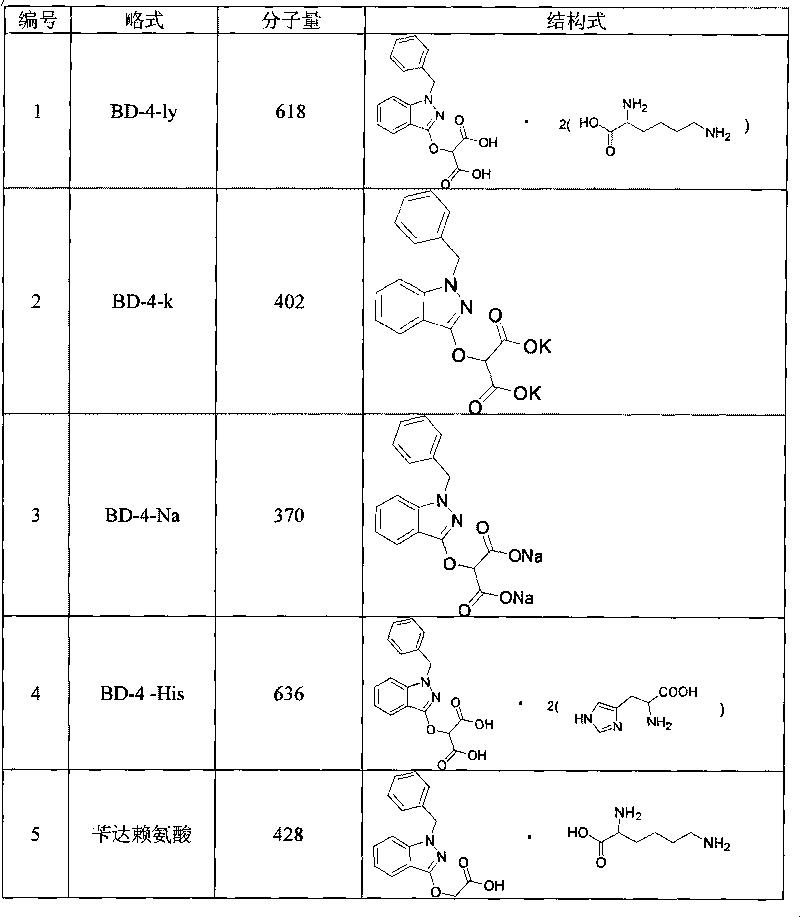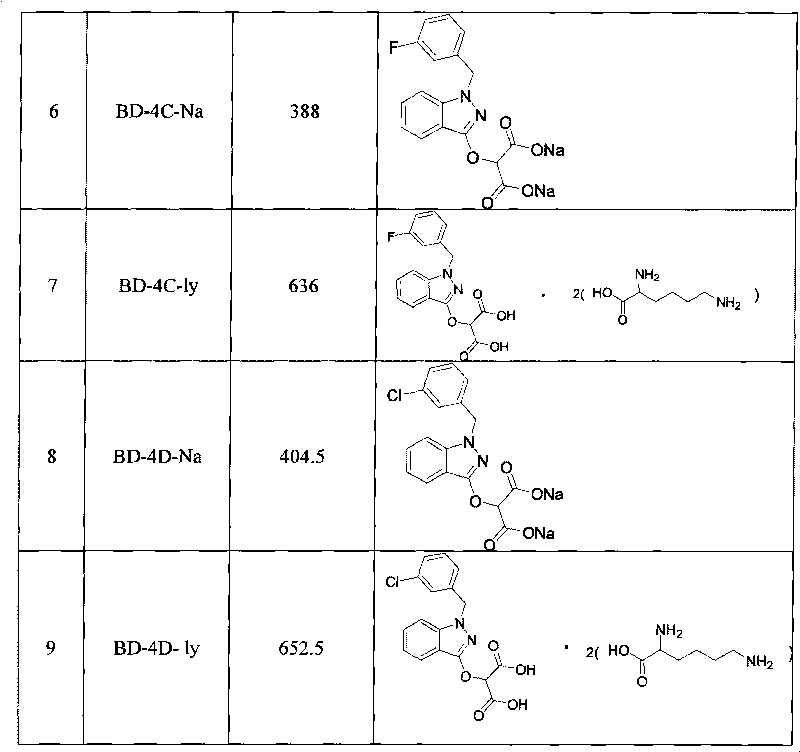Application of organic dicarboxylic acid salts in preparing medicaments for preventing and treating cataract
An organic dicarboxylate and cataract technology, which is applied in the application field of medicine, can solve the problems of reducing benzyl lysine eye drops, increasing patient compliance, influence, etc., and achieving enhanced antioxidant capacity and high effect intensity. , the effect of high efficiency
- Summary
- Abstract
- Description
- Claims
- Application Information
AI Technical Summary
Problems solved by technology
Method used
Image
Examples
Embodiment 1
[0013] One class of organic dicarboxylates is eight kinds of monomeric compounds derived from Bendalysine. Its chemical structural formula and number are as follows:
[0014]
[0015]
[0016] Bendalysine (BDL, No. 5) is provided by Zhejiang Shapuaisi Pharmaceutical Co., Ltd., with a purity greater than 98.5%. Compounds No. 1-9 are prepared by dissolving in different solutions according to different tests, such as: Acute intravenous injection test, chick embryo allantoic membrane irritation test, eye irritation blink test, use 0.9% NaCl (WT) solution, acute poison gavage test with 0.5% (WT) carboxymethyl cellulose solution to clean the lens Use pH 7.2 phosphate buffer solution, commercially available Bendalysine eye drop formula for allergy test, and DMEM cell culture medium for anti-oxidation test of lens, etc. Under the above conditions, No. 1-5 is easy to dissolve in water, No. 6-9 is not easy to dissolve in water, especially No. 8 is not easy to dissolve in water. T...
Embodiment 2
[0048] Example 2 Experimental Research on Resisting Oxidative Damage of Lens
[0049] 1. Materials
[0050] 1.1. Experimental animals: rats, guinea pigs, rabbits, both male and female.
[0051] 1.2. Main reagents and drugs:
[0052] DMEM / high glucose (high sugar) culture medium was purchased from Thermo Fisher Biochemical Co., Ltd. (Beijing), vitamin C, 30% (VT) H 2 o 2 , FeCl 3 , NaCl, Na 2 HPO 4 and NaH 2 PO 4 etc. are commercially available AR-grade reagents. Xylose (D+xylose) is commercially available HGB-grade reagents.
[0053] 1.3. Main equipment: ultra-clean bench, CO 2 Incubator, homogenizer, low-temperature high-speed centrifuge, visible spectrophotometer, 12-well culture plate.
[0054] 2. Method
[0055] 2.1. Lens culture: kill the rats and rabbits, take out the eyeball and rinse it with normal saline containing 500u / mL penicillin, carefully cut the eyeball from the posterior way to remove the bulb wall and vitreous body, peel off the zonule, take out th...
Embodiment 3
[0091] Embodiment 3 and commercially available Bendalysine eye drops (No. 5) comparative test on eye irritation
[0092] 1 Materials and methods
[0093] 1.1 Test samples and reagents
[0094] In vitro test: Compounds No. 1-9 of the test samples, including Bendalysine as the reference substance, were formulated with 0.9% wtNaCl to a concentration of 70mmol / L. A 0.9% wtNaCl solution was used as a control test, and all chemical reagents used were of analytical grade. Compound No. 1-5 in vivo test: all were prepared with 0.9% wtNaCl to prepare colorless and clear eye drops with a specification of 5 mL: 25 mg. No. 6-9 have not been tested in vivo.
[0095] 1.2 Animals and instruments
[0096] Chicken embryos aged 10 days were provided by Nanjing Nanjiao Breeding Chicken Factory. 21 New Zealand big-eared white rabbits, weighing 2.5±3.0kg, both male and female. Provided by the Experimental Animal Center of Nanjing Medical University. OLYMPUS inverted microscope, Queue carbon ...
PUM
 Login to View More
Login to View More Abstract
Description
Claims
Application Information
 Login to View More
Login to View More - R&D
- Intellectual Property
- Life Sciences
- Materials
- Tech Scout
- Unparalleled Data Quality
- Higher Quality Content
- 60% Fewer Hallucinations
Browse by: Latest US Patents, China's latest patents, Technical Efficacy Thesaurus, Application Domain, Technology Topic, Popular Technical Reports.
© 2025 PatSnap. All rights reserved.Legal|Privacy policy|Modern Slavery Act Transparency Statement|Sitemap|About US| Contact US: help@patsnap.com



